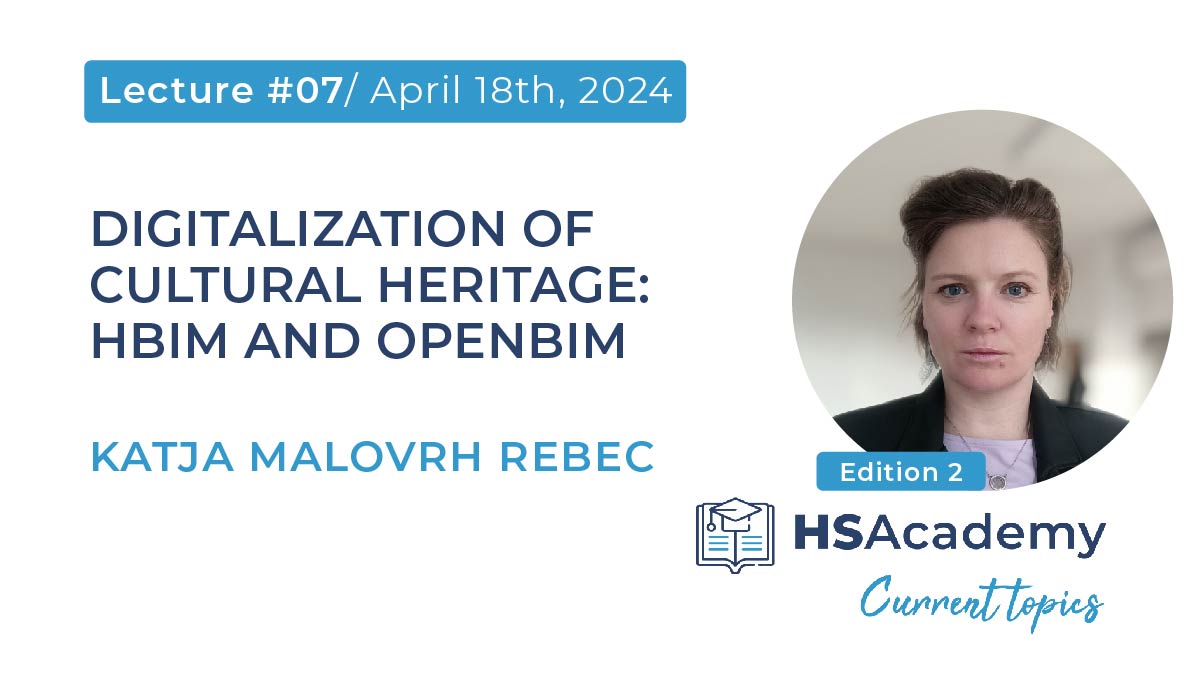
CTinHS Lecture 7 – 2023/24:
Katja Malovrh Rebec will deliver the 7th lecture of the 2nd edition of the “Current Topics in Heritage Science” on the topic: Digitalization of cultural heritage: HBIM and OpenBIM on Thursday, April 18th, at 3.00 pm (CEST).
Digitalization of cultural heritage: HBIM and OpenBIM
The importance of digitization in protected buildings and constructions cannot be overstated. It facilitates the efficient management, preservation, and enhancement of cultural heritage through the use of advanced technologies such as Heritage Building Information Modeling (HBIM). This is complemented by the integration of Artificial Intelligence (AI), scan-to-BIM technologies, virtual and augmented reality (VR/AR) representations, holograms, and massive data analysis, which enable detailed and accurate documentation and analysis of cultural heritage sites. Using drones and digital knowledge repositories, including citizen science initiatives, further enhances the accessibility and preservation of built cultural heritage. These technologies not only support the conservation and restoration efforts but also promote the public’s engagement and understanding of cultural heritage. In the lecture, we will look into the reasons why HBIM and openBIM supported by ISO 16739:2013, is the most common ontology. We will present different case studies, including the conservation plan for a protected seventeenth-century residential building planned for restoration and the digital representation of the tallest building in the capital as it was erected in the 1980s. These examples will serve as practical use cases. We will also discuss the use of MVD (Model View Definition) and energy use modelling coupled with environmental footprint calculations (Life Cycle Assessment – LCA). We will also touch upon fascinating trends for the future of digitization in construction and cultural heritage, particularly in the context of built heritage with completely new knowledge domains and seeking innovative skill sets for future experts.
Date
April 18, 2024 at 3 pm (CEST)
You will learn
- Understand the critical role of digitization in the preservation and enhancement of cultural heritage through technologies like Heritage Building Information Modeling (HBIM).
- Learn about the integration of Artificial Intelligence (AI), scan-to-BIM technologies, virtual and augmented reality (VR/AR) representations, holograms, and massive data analysis in the documentation and analysis of cultural heritage sites.
- Gain insights into the use of drones and digital knowledge repositories, including citizen science initiatives, to enhance the accessibility and preservation of built cultural heritage.
- Explore the reasons behind the widespread adoption of HBIM and openBIM supported by ISO 16739:2013 as the most common ontology in the field.
- Discover practical use cases through case studies, including the conservation plan for a protected seventeenth-century residential building and the digital representation of the tallest building in the capital as it was erected in the 1980s.
Key topics we’ll cover
- The role of digitization in the preservation and enhancement of cultural heritage through advanced technologies like Heritage Building Information Modeling (HBIM).
- The integration of Artificial Intelligence (AI), scan-to-BIM technologies, and virtual/augmented reality (VR/AR), drones and digital knowledge repositories, including citizen science initiatives, to improve the accessibility and preservation of built cultural heritage.
- The reasons behind the widespread adoption of HBIM and openBIM, supported by ISO 16739:2013, as the most common ontology in the field.
- Practical case studies, including the conservation plan for a protected seventeenth-century residential building and the digital representation (BIM and hologram) of the tallest building in the capital as it was erected in the 1980s, to illustrate the application of these technologies.
- The exploration of Model View Definition (MVD) and energy use modelling coupled with environmental footprint calculations (Life Cycle Assessment – LCA) for sustainable building practices.
- Discussion on future trends in digitization for construction and cultural heritage, focusing on innovative skill sets for future experts and new knowledge domains.
Duration
45 minutes (30 minutes presentation + 15 minutes Q&A)
Speaker
Assist. Prof. Katja Malovrh Rebec, PhD, is Head of The Department and Laboratory for Building Physics at the Slovenian National Building and Civil Engineering Institute (ZAG). She started and leads a horizontal research group Digitalization at ZAG since 2018. She holds compulsory course for the Master’s degree level titled Energy Efficient Building Design at the University of Primorska, Faculty of Mathematics, Natural Sciences and Information Technologies. Her research topics are digitalization of built environment, BIM*HBIM, lighting and human responses and environmental impacts of built environment including energy use and decarbonatization of buildings. Currently, two researchers are pursuing their PhDs under her guidance in digitalization field of study.
